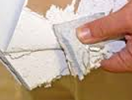![]() Printable PDF About Chinese Drywall
Printable PDF About Chinese Drywall
What is Chinese Drywall
"Chinese drywall" refers to an environmental health issue involving defective drywall manufactured in China and imported to the United States starting in 2001. Laboratory tests identified emissions of sulfurous gases. The drywall emits odors of rotten eggs which worsen as temperature and humidity rise and cause copper pipes, wiring, and air conditioner coils to turn black and powdery.

What are the concerns
The Center for Disease Control, in collaboration with The Agency for Toxic Substances and Disease Registry released a guide indicating the residents of affected homes reported irritated and itchy eyes and skin, difficulty breathing, persistent cough, bloody noses, runny noses, recurrent headaches, sinus infection, and asthma attacks. There are no conclusive studies of the long term effects. Early reporting raised concerns about the presence of radioactive gases emitted. Tests of drywall samples by the EPA and the Florida Department of Health showed radioactivity at levels no higher than those ordinarily found in the natural environment.
In the United States, most complaints have come from states in the Southeast, where a warm and humid climate encourages the emissions. Florida accounted for more than 50% of the 3,952 cases reported to the U.S. Consumer Product Safety Commission as of 2012. Sources estimate that 60,000 to 100,000 homes could be affected.
How did this happen:
Drywall is made of a layer of gypsum-based plaster pressed between two thick sheets of paper. Due to the building boom in the early 2000's and the hurricanes of 2004 and 2005 U. S. supplier could not keep up with demand. Between 2004 and 2007 approximately 550 million pounds of Chinese drywall were imported into the United States, enough to build 60,000 average-sized homes.
What is the problem:
Lab comparisons of Chinese and American made drywall show significantly higher levels of "pyrite" in the Chinese material. This suggests that pyrite oxidation may be the source of the sulfur compounds released by Chinese drywall. The problems have been attributed to the use of fly ash in the drywall, which degrades in the presence of heat and moisture. Although United States' drywall uses fly ash as well, the process used creates a cleaner final product. Knauf Plasterboard Tianjin Co. Ltd., has been cited as the major source of contaminated drywall because most of the other contaminated drywall has no markings.
What are the signs and the solution:
Signs of tainted drywall include a blue/green or dark red color on copper coils, piping and wiring and the smell of rotten eggs (sulfur). If the back sides of drywall can be accessed in attics or under stairwells a manufactures stamp may be located indicating foreign or domestic manufacture. Chinese's drywall may be darker in color than domestic manufactured product. Drywall samples can be sent to a lavatory for testing. Homes may have a mix of foreign and domestically produced drywall. Remediation requires removal of all drywall and any effected copper products.
Where do we stand:
In 2009 States, Congress and other Agencies studied the concern and legislation was passed which increased the strictures on the importation of foreign manufactured drywall products. From 2001 to 2009 tainted drywall was imported to the United States with the greatest concern being homes built between 2004 and 2008. Most homes with Chinese's Drywall have been located and remediate although concerns can still be found.
For more information check:
US Dept of Health and Human Services:
http://www.cpsc.gov/en/Safety-Education/Safety-Education-Centers/Drywall-Information-Center/How-can-I-tell-if-my-home-has-problem-drywall/
Florida Dept of Health:
http://www.floridahealth.gov/ENVIRONMENTAL-HEALTH/drywall/index.html




















